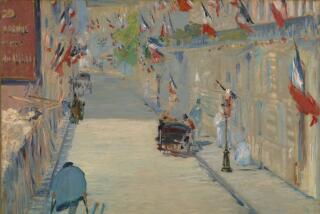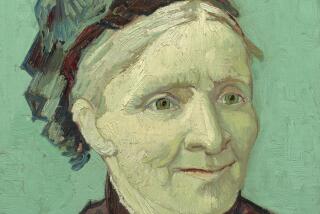Lust for Life
- Share via
Frederic Tuten has built a wall, brick but permeable, between history and the end of history. Because he is a lover of painting and literature, his history pertains specifically to the urge of men and women to make art and to prize themselves so much that when they consume themselves doing it, a lot has been paid and a lot achieved.
Up through Modernism, history was real trees used to make real and lasting tables and chairs. History’s end, from Postmodernism on, is a polymer extrusion process used to make transient collectibles. Tuten, who lives on this side--Roy Lichtenstein, his friend, did the cover for his last book, “Tintin in the New World,” and Eric Fischl, another friend, has done the cover and 10 drawings for this one--takes no sides. He does mourn, though, which may be different--or perhaps it would be more exact to say that he brings his readers to mourn.
The wall in Tuten’s tiny but powerfully alluring “Van Gogh’s Bad Cafe” appears suddenly in a scrubby vacant lot on the alphabet-city streets of New York’s far East Side. The narrator, a desultory art photographer on a small trust fund, comes upon it on a ramble down to the East River. It is a fierce July day, one where “the blaze of sun bakes your brains unless you’re wearing a straw hat with a high crown.”
The hat is important. It links the two eras in which the story is played out. When the narrator (call him N for convenience) comes to the wall, and it blurs and opens, the figure that emerges--slender, ravishing, red-haired--is Ursula. Tuten invents her as the lover of Vincent Van Gogh during his last months at Auvers-sur-Oise. Van Gogh wears his straw hat on the 19th century side of the wall; N wears his on the late 20th century side. “Bad Cafe” brings the sun-threatened men together in their historic and post-historic contrast, though they never actually meet. It is Ursula, their muse and passion, who is the agent and medium of the encounter. The transformation she goes through in the book is the transformation of one century to the other: of art to the end of art. She lives in both centuries, on both sides of the wall. She is entrancing and terrible. She is time.
A morphine addict, she was looking in the back garden of the Auvers cafe for her supplier. Seeing the hole in the wall, she stepped through. Meeting N on the other side, she asks, in a French garbled by the only misprint in this finely produced book, if he is the one who has what she needs. A graceful and comical time-travel sequence follows. N takes her home; she strips off her long white dress and unusually abundant underwear. He assumes she has been to an antique clothing store. He is skeptical and not skeptical of who she claims to be: Tuten both distinguishes and blurs his characters, as he distinguishes and blurs time. N has his own limited knowledge and his author’s expanded one. Bathing her, he observes: “I was washing off her past; the apricot patina of the 19th century.”
The comedy gives way to something else, though it does not disappear. Tuten is a supremely elegant writer; his somber messages, some violent, come through without deranging his texture. Ursula is amusingly French; N’s apartment, she pronounces, “has its negligent charm, a little like Vincent’s.” She looks at N’s work, a disconnected anthology of arty photographs. Much of it is unexposed; his passion is for making the shot, not for developing or printing it. “They are not seasoned,” Ursula says.
It is the formidable judgment of art’s history upon its present. Art as total commitment and service to the work versus art as simply the reflection of the artist’s personal energies and ambition.
The second part of the book takes us back through the wall, as Ursula tells Van Gogh’s story and hers. It is an imaginatively brilliant rendering of the artist, whose passion was to become visible to God. He failed miserably to do it when preaching to the miners in the Borinage; he will do it painting. Tuten achieves a vivid, many-layered portrait of the torment and purposes of this awkward, loving figure. There are hallucinatory passages; one section, describing Van Gogh’s first meeting with Ursula, who had invited him to tea, comes in two differing versions. The first is pure passion, the second a broader, sinuous mystery.
The two stories could be taken, in the current fashion of literary theory, as casting doubt on the reality of anything outside the narrative itself. Tuten goes beyond this. The life and struggles of Van Gogh and Ursula possess such magical intensity, as he writes them, that the message is quite the opposite. Narratives do not replace reality; rather, they are partial attempts to reach it, incomplete mountaineering assaults on an unscalable mountain.
This, at least, is conveyed in the magically vital second part of the book. The portrait of Ursula is equally vivid: a brilliant, tormented, bisexual woman, a visionary photographer who is beginning to experiment with abstract renditions of light. She represents the future that by and by she will enter, but she does it with the artistic passion of her 19th century.
She worships Van Gogh and quarrels furiously with him; some foretaste of the Postmodern has her denounce the emotion of his work even as she yields to it. Beyond all this, she is as fragile as he is--an entrancing, wonderfully realized woman of rending contradictions. Morphine is her means of blurring and surviving them.
In the book’s third part, high colors fade from the world. Ursula, living with the besotted N--she is the closest thing to classic passion that his Postmodern temperament has ever experienced--charges through something like 50 years of history on her way toward the end of art. She begins avidly taking pictures with N’s Leica. She drops art as creation to take up art as celebrity, becoming the star of the local artists’ hangout. She goes through punk and radical feminism. She denounces Van Gogh as a male imperialist without quite overcoming her tenderness for him.
Bit by bit, she slips into an addiction far more intense than morphine’s. Heroin ravages her. Instead of letting her cope with the disrupting passions of life and art, the new drug replaces them. There is nothing left but to step back through the wall. Time goes only one way; her step unleashes a galactic shudder that produces a disastrous transformation.
N is a puny counterpart to Van Gogh; his fantasy of arm-wrestling with him is his nearest approach to the heroic artistic tradition. Ursula going downhill in New York has the drabness of the fading trendy. The characters’ power and witchery remain on the other side of the wall. They may be products of romantic myth, but the myth inhabits them vitally, humanly, as the soul inhabits a body we love.
In “Van Gogh’s Bad Cafe,” his finest book, Tuten has brought to fruition what I think he was aiming at in the diverting but self-conscious “Tintin.” His message about the end of art has become a work of art, and almost too sad to bear.
More to Read
Sign up for our Book Club newsletter
Get the latest news, events and more from the Los Angeles Times Book Club, and help us get L.A. reading and talking.
You may occasionally receive promotional content from the Los Angeles Times.








